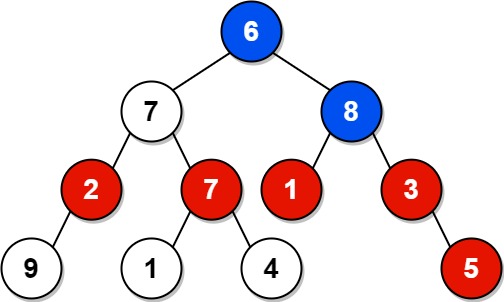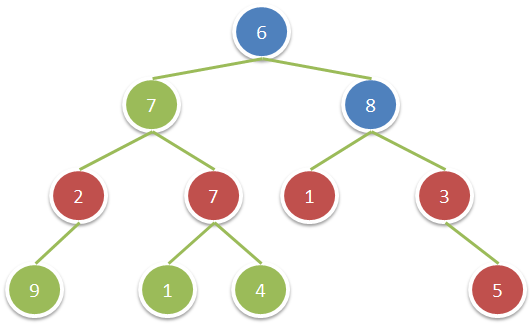原文链接: https://leetcode-cn.com/problems/sum-of-nodes-with-even-valued-grandparent
英文原文
Given the root of a binary tree, return the sum of values of nodes with an even-valued grandparent. If there are no nodes with an even-valued grandparent, return 0.
A grandparent of a node is the parent of its parent if it exists.
Example 1:

Input: root = [6,7,8,2,7,1,3,9,null,1,4,null,null,null,5] Output: 18 Explanation: The red nodes are the nodes with even-value grandparent while the blue nodes are the even-value grandparents.
Example 2:

Input: root = [1] Output: 0
Constraints:
- The number of nodes in the tree is in the range
[1, 104]. 1 <= Node.val <= 100
中文题目
给你一棵二叉树,请你返回满足以下条件的所有节点的值之和:
- 该节点的祖父节点的值为偶数。(一个节点的祖父节点是指该节点的父节点的父节点。)
如果不存在祖父节点值为偶数的节点,那么返回 0 。
示例:

输入:root = [6,7,8,2,7,1,3,9,null,1,4,null,null,null,5] 输出:18 解释:图中红色节点的祖父节点的值为偶数,蓝色节点为这些红色节点的祖父节点。
提示:
- 树中节点的数目在
1到10^4之间。 - 每个节点的值在
1到100之间。
通过代码
高赞题解
方法一:深度优先搜索
我们可以通过深度优先搜索找出所有满足题目要求的节点。
具体地,在进行搜索时,搜索状态除了当前节点之外,还需要存储该节点的祖父节点和父节点,即三元组 (grandparent, parent, node)。如果节点 grandparent 的值为偶数,那么就将节点 node 的值加入答案。在这之后,我们继续搜索节点 node 的左孩子 (parent, node, node.left) 以及右孩子 (parent, node, node.right),直到搜索结束。
[sol1-C++]class Solution { private: int ans = 0; public: void dfs(TreeNode* grandparent, TreeNode* parent, TreeNode* node) { if (!node) { return; } if (grandparent->val % 2 == 0) { ans += node->val; } dfs(parent, node, node->left); dfs(parent, node, node->right); } int sumEvenGrandparent(TreeNode* root) { if (root->left) { dfs(root, root->left, root->left->left); dfs(root, root->left, root->left->right); } if (root->right) { dfs(root, root->right, root->right->left); dfs(root, root->right, root->right->right); } return ans; } };
[sol1-Python3]class Solution: def sumEvenGrandparent(self, root: TreeNode) -> int: ans = 0 def dfs(grandparent, parent, node): if not node: return if grandparent.val % 2 == 0: nonlocal ans ans += node.val dfs(parent, node, node.left) dfs(parent, node, node.right) if root.left: dfs(root, root.left, root.left.left) dfs(root, root.left, root.left.right) if root.right: dfs(root, root.right, root.right.left) dfs(root, root.right, root.right.right) return ans
然而这种搜索状态的表示方法不够通用。在上面的代码中,我们需要使用两次 if 进行四次搜索函数的调用,才能完成树中所有节点的搜索。那么如何将代码写得更加通用和美观呢?
我们想一想为什么需要在代码中使用两次 if 进行四次搜索:由于根节点没有父节点,根节点的子节点没有祖父节点,那么搜索状态中的grandparent 和 parent 无法进行表示,因此我们必须从根节点的孙子节点(即子节点的子节点)开始搜索。而我们发现,在搜索状态三元组 (grandparent, parent, node) 中,grandparent 和 parent 这两项我们只使用了它的值,而不使用节点本身,因此我们可以在搜索状态中用值来替换这些节点。
我们可以假设根节点有一个虚拟的祖父节点和父节点,它们的值都为 1。在搜索时,我们使用三元组 (gp_val, p_val, node) 表示搜索状态,其中 gp_val 和 p_val 分别表示祖父节点和父节点的值,node 表示当前节点。这样以来,我们就可以直接从状态 (1, 1, root) 开始直接对根节点进行搜索了。
[sol2-C++]class Solution { private: int ans = 0; public: void dfs(int gp_val, int p_val, TreeNode* node) { if (!node) { return; } if (gp_val % 2 == 0) { ans += node->val; } dfs(p_val, node->val, node->left); dfs(p_val, node->val, node->right); } int sumEvenGrandparent(TreeNode* root) { dfs(1, 1, root); return ans; } };
[sol2-Python3]class Solution: def sumEvenGrandparent(self, root: TreeNode) -> int: ans = 0 def dfs(gp_val, p_val, node): if not node: return if gp_val % 2 == 0: nonlocal ans ans += node.val dfs(p_val, node.val, node.left) dfs(p_val, node.val, node.right) dfs(1, 1, root) return ans
复杂度分析
时间复杂度:$O(N)$,其中 $N$ 是树中的节点个数。
空间复杂度:$O(H)$,其中 $H$ 是树的高度。
方法二:广度优先搜索
我们也可以换一种思考方式。既然要找出祖父节点的值为偶数的节点,我们不如找到所有值为偶数的节点,并对这些节点的孙子节点(即子节点的子节点)统计答案。
这样我们就可以使用广度优先搜索遍历整棵树,当我们找到一个值为偶数的节点时,我们将该节点的所有孙子节点的值加入答案。
[sol3-C++]class Solution { public: int sumEvenGrandparent(TreeNode* root) { queue<TreeNode*> q; q.push(root); int ans = 0; while (!q.empty()) { TreeNode* node = q.front(); q.pop(); if (node->val % 2 == 0) { if (node->left) { if (node->left->left) { ans += node->left->left->val; } if (node->left->right) { ans += node->left->right->val; } } if (node->right) { if (node->right->left) { ans += node->right->left->val; } if (node->right->right) { ans += node->right->right->val; } } } if (node->left) { q.push(node->left); } if (node->right) { q.push(node->right); } } return ans; } };
[sol3-Python3]class Solution: def sumEvenGrandparent(self, root: TreeNode) -> int: q = collections.deque([root]) ans = 0 while len(q) > 0: node = q.popleft() if node.val % 2 == 0: if node.left: if node.left.left: ans += node.left.left.val if node.left.right: ans += node.left.right.val if node.right: if node.right.left: ans += node.right.left.val if node.right.right: ans += node.right.right.val if node.left: q.append(node.left) if node.right: q.append(node.right) return ans
复杂度分析
时间复杂度:$O(N)$,其中 $N$ 是树中的节点个数。
空间复杂度:$O(N)$。
统计信息
| 通过次数 | 提交次数 | AC比率 |
|---|---|---|
| 13256 | 16359 | 81.0% |
提交历史
| 提交时间 | 提交结果 | 执行时间 | 内存消耗 | 语言 |
|---|




